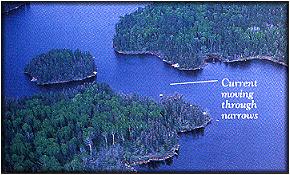Smallmouths sometimes do well when stocked in lakes and
reservoirs. They are best suited to those impoundments that
have moderately clear water, some spots over 25 feet deep,
and rocky points, reefs, ledges and other structure that
supports a good population of crawdads (also known as crayfish
in some parts of the country). Smallmouths tend to concentrate
around river mouths and in areas where the wind produces some
amount of current. Gravel pits sometimes produce good smallmouth
fishing if they have good populations of crawdads and minnows
present.
You must remember one thing above all else when smallmouth fishing
with flies: most of your fishing will be done in sandy, rocky places,
and that means the hook points on your flies are going to take a
beating and will need frequent sharpening. Like the largemouth, the
smallmouth has a tough mouth and bony jaw. A hook must be very
sharp to penetrate that tough tissue, especially when you are trying
to drive the point home with a limber fly rod.
To become a good smallmouth fisherman you must first train
yourself to ignore, for a time, all the information you've
accumulated about fishing for largemouth bass. You have to adopt
different tactics and force yourself to fish different types of
structure.

Because smallmouths favor clear, moving water, they can usually
be found at inlet areas where creeks flow into the lake, along
rocky shorelines where wind keeps waves splashing against the shore,
or in narrow channels between islands where the wind keeps water
moving. When lake fishing, look for rocky points, small rocky
ledges and shallow rocky or sandy reefs - spots where you'd expect to
find crawdads. Once you locate crawdads, chances are you'll find
smallmouth bass close-by. But crawdads aren't the only delicacies
listed on the smallmouth's menu. They also have a fondness for
water beetles, nymphs, leeches, grasshoppers, minnows and frogs.
We use flies that imitate all of these critters for smallmouth
fishing. In the spring I like to fish water beetle and nymph
imitations around the inlet areas, casting up into the creek and
letting the current wash the fly along, as it flows into the lake.
This tactic also works well with grasshopper patterns from mid-summer
into the fall because many fall into the water or are blown off the
stream banks and are carried into the lake.
During the warm months I like to use leech flies and cast them
around lily pads, cattails and masses of floating algae where live
leeches are generally found. This is a case of casting as close to
the vegetation as possible, and retrieving the fly while erratically
making the leech swim with short darting movements. I try to retrieve
the fly parallel to the vegetation to keep it in potentially productive
water as long as possible on each cast. I spend a lot of time working
small openings among the weed growth and fish them as carefully and
thoroughly as possible with the leech.
The Deerhair Bumblepup Popper is an effective imitation of a
small frog, another critter high on the smallmouth's list of favorite
foods. To enjoy some excitingh topwater smallmouth action, fish the
popper the same way you would for largemouth bass, except cast it to
shallow rocky areas rather than to masses of shoreline vegetation. If
the water is choppy and the waves are a little too large for effective
popper fishing, try fishing beneath the surface with a Black and
White Long Streamer. Use a sink-tip fly line to get the fly deep
and give it the proper action to make it imitate a wounded minnow
swimming around and over submerged rocks.
During the early spring, smallmouths cruise slowly along rocky
dam faces or rock-strewn shorelines in both lakes and streams looking
for groceries, and that means it's time to tie on a crawdad pattern.
Cast the crawdad along the bottom. Give the line a sharp jerk
occassionally to make the fly scoot a few inches and kick up
silt from the bottom, like a live crawdad does as it scurrys away
from danger.
When you're fishing crawdads in streams, try casting upstream
and allow the fly to drift back downstream about like you would
a nymph. Let the current carry the crawdad past you, feed out some
line to continue the drift, and them retrieve it along the bottom
in a series of short, darting jerks.
Always fish crawdad patterns near rocky areas in spots where
you would expect to find real crawdads. I like to cast into shallow
eddies where crawdads stay out of the direct current, but if I don't
get a strike there I try to change my luck by casting into deeper
pools.
Crawdad patterns can be dynamite when fished below dams in the
tailrace area and in adjacent pools of slack water. If the river is
shallow near the shoreline, try wading out and casting upstream
parallel to the bank, so the current will carry your fly along
the bottom in 4 to 6 feet of water.
We've found a good way to keep the fly down on or near the bottom
is by using a weighted fly on a sink-tip line. When I must cast
from shore I locate a spot where the current flows right along the shore,
then let the fly move slowly down and past me, just like I would if I
was wading.
The key to fishing a crawdad pattern in swift water is using
enough weight to keep the fly moving slowly, instead of allowing it
to be swept along at the same speed as the fast-moving current. When
retrieving the fly across stream or upstream against the current, make
it move in a series of very short darts and pauses along the bottom
in the same manner a live crawdad moves. ~ Tom Keith
More on Smallmouth Bass Fishing Next time!
|



